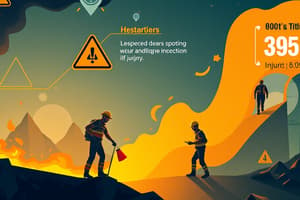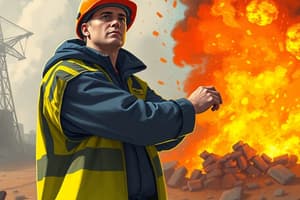Podcast
Questions and Answers
What is the primary aim of hazard recognition in the workplace?
What is the primary aim of hazard recognition in the workplace?
- To identify and eliminate workplace hazards to reduce incidents (correct)
- To increase productivity through better planning
- To enhance the communication between employees
- To implement new technologies for monitoring safety
Which of the following exemplifies physical hazards in the workplace?
Which of the following exemplifies physical hazards in the workplace?
- Repetitive motions that cause strain
- Hazardous materials and fumes
- Slips, falls, and cuts (correct)
- Improper lifting techniques
How many near misses occur for every 20,000 hazards present in a workplace?
How many near misses occur for every 20,000 hazards present in a workplace?
- 4,500
- 1,500 (correct)
- 300
- 27
What is a Job Hazard Analysis used for?
What is a Job Hazard Analysis used for?
What regular action should be taken to assess workplace hazards?
What regular action should be taken to assess workplace hazards?
What does the pyramid diagram illustrate regarding workplace hazards?
What does the pyramid diagram illustrate regarding workplace hazards?
What is a crucial part of accident investigation in the workplace?
What is a crucial part of accident investigation in the workplace?
Which of the following is an example of an ergonomic hazard?
Which of the following is an example of an ergonomic hazard?
Flashcards are hidden until you start studying
Study Notes
Importance of Hazard Recognition
- Looking both ways before crossing the street exemplifies basic hazard recognition, translating to workplace safety protocols.
- Over 3 million workplace injuries and 4,500 fatalities occur annually, highlighting significant safety concerns.
Connection Between Hazards and Incidents
- The greater the number of hazards in a workplace, the higher the risk of accidents and injuries.
- A pyramid diagram illustrates the relationship between hazards, near misses, minor injuries, major injuries, and fatalities.
- Statistics reveal that for every 20,000 hazards, there are 1,500 near misses, 300 minor injuries, 27 major injuries, and 1 fatality.
Goals of Hazard Recognition
- The primary aim is to identify and eliminate workplace hazards to reduce incidents.
- Reducing hazards leads to a decrease in accidents, injuries, and fatalities.
Types of Hazards
- Hazardous conditions include:
- Physical hazards (e.g., slips, falls, cuts).
- Ergonomic hazards (e.g., repetitive motions, awkward lifting).
- Chemical hazards (e.g., hazardous materials and fumes).
- Biological hazards (e.g., viruses, mold).
- Unsafe acts are practices that increase accident risks, like using damaged tools or ignoring safety protocols.
Tools for Hazard Recognition
- Job Hazard Analysis: Identifies potential hazards in projects or tasks, creating plans to mitigate them.
- Pre-shift and Pre-operation Inspections: Systematic checks at the start of shifts or tasks to identify and address hazards.
- Work Permits: Required for hazardous tasks, detailing hazards and control measures that need managerial approval.
Real-time Hazard Identification
- Regularly assess hazards throughout the workday, focusing on physical, ergonomic, chemical, and biological dangers.
- Spot potential issues such as improper equipment, hazardous energy sources, and unsafe acts by co-workers.
- Report hazards immediately to supervisors and ensure proper communication regarding safety risks.
Importance of Accident Investigation
- Understanding the root causes of accidents can prevent future occurrences.
- Examining incidents reveals underlying issues that may not be immediately evident.
- Providing insights from personal knowledge about the task or location can aid investigations.
Summary of Hazard Recognition Principles
- Effective hazard recognition can lower workplace accidents by proactively identifying and addressing hazards.
- Consistent identification and action toward hazards foster a safer work environment.
Importance of Hazard Recognition
- Basic hazard recognition is exemplified by looking both ways before crossing the street, applicable to workplace safety.
- Annually, over 3 million workplace injuries and approximately 4,500 fatalities underscore pressing safety issues.
Connection Between Hazards and Incidents
- Increased hazards in a workplace correlate with a higher likelihood of accidents and injuries.
- A pyramid diagram effectively depicts the progression from hazards to near misses, minor injuries, major injuries, and fatalities.
- Data indicates that for every 20,000 identified hazards, there are typically 1,500 near misses, 300 minor injuries, 27 major injuries, and 1 fatality.
Goals of Hazard Recognition
- The primary objective is to identify and eliminate workplace hazards to minimize incidents and enhance safety.
- Effective hazard reduction is directly linked to fewer accidents, injuries, and fatalities in the workplace.
Types of Hazards
- Physical hazards include risks like slips, falls, and cuts.
- Ergonomic hazards arise from repetitive motions and improper lifting techniques.
- Chemical hazards involve exposure to hazardous materials and toxic fumes.
- Biological hazards consist of risks from viruses, mold, and other pathogens.
- Unsafe acts refer to behaviors that heighten accident risks, like using damaged equipment or neglecting safety protocols.
Tools for Hazard Recognition
- Job Hazard Analysis: A systematic approach to identify potential hazards in projects and devise mitigation plans.
- Pre-shift and Pre-operation Inspections: Conducting thorough checks before shifts or tasks to pinpoint and resolve hazards.
- Work Permits: Required documentation for high-risk tasks, outlining hazards and necessary control measures subject to management approval.
Real-time Hazard Identification
- Continuous assessment of hazards throughout the workday is critical; focus on physical, ergonomic, chemical, and biological threats.
- Potential issues can include improper equipment usage, exposure to hazardous energy sources, and unsafe practices by colleagues.
- Immediate reporting of hazards to supervisors is vital for maintaining workplace safety and clear communication regarding risks.
Importance of Accident Investigation
- Investigating accidents helps unveil root causes and prevents recurrence.
- Analyzing incidents can highlight underlying issues that may not be readily apparent.
- Insights from personal experience or knowledge about specific tasks or environments can significantly contribute to thorough investigations.
Summary of Hazard Recognition Principles
- Proactive hazard recognition significantly reduces workplace accidents by identifying and addressing risks.
- Regular identification and responsive action toward hazards contribute to a safer working environment.
Studying That Suits You
Use AI to generate personalized quizzes and flashcards to suit your learning preferences.




